If you’re wondering when to train a puppy for agility, well, you can start some of the training right away! I’ll get into some details on what is safe for a puppy and what isn’t.
My own dog is a 5-year-old weimaraner, and I didn’t start training him for agility until he was 2 years old.
I wish I’d started much earlier!
It’s never too late though, and my dog is doing great! I just know that with my next dog I’ll start working on some agility foundation skills, focus and body awareness much earlier.
*This article is based on my opinions and experience. I am a member of a local agility club and help teach the beginning agility class for young dogs. You have to make your own decision on when to train a puppy for agility. Consult with your puppy’s vet, breeder and agility trainer.
When to train a puppy for agility
Sports can be hard on the body. Dog agility involves jumping, sprinting, hard turns and slamming up and down obstacles.
Some dog owners choose not to train their dogs for agility at all because it CAN be hard on the dog’s body and joints, especially over time. This is the case with most sports.
With a puppy’s developing joints, you definitely don’t want her pounding and crashing through the equipment. Most organizations require dogs to be at least 15 months old before they can compete in agility, and I think that is a good standard.
Give your puppy time to develop first while you help her build strength and flexibility. Allow for her growth plates to close (around 12 to 18 months, depending on breed).
When in doubt, always check with your vet or breeder or other breed expert on when to train a puppy for agility. Every dog is a bit different.
But … this doesn’t mean you can’t start training your puppy for agility early! Just go easy on her and introduce some foundation work.
Let’s look at:
- Beginning agility obstacles for puppies
- Contact obstacles and jumps for puppies
- Agility foundation work for puppies
- Obedience for puppies
- Conditioning for puppies
Safe beginning agility obstacles for all puppies
I’ll talk about obstacles first because that’s what everyone is most interested in. However, obstacles are actually the easy part of agility. The handling, directional skills, body awareness and communication are the hard parts!
Safe agility obstacles for puppies:
Tunnels: The dog or puppy simply runs through a tunnel on the ground.
Barrels: Barrels are an obstacle used in NADAC agility (North American Dog Agility Council). The dog simply needs to run around the barrel in the correct directiom.
Hoops: In NADAC agility, “hoops” are right on the ground so all the dog has to do is run through the hoop. No jumping is involved at all.
You should also introduce your puppy to walking on a low board and to step on different surfaces. This will help him learn some body awareness.
Avoid until your puppy is at least 6 months old:
- Contact obstacles
- Jumps
- Weaves
Are the agility contact obstacles safe for puppies?
Contact obstacles in agility include:
- “A-frame”
- “Dog walk”
- “Teeter” (in AKC agility)
I don’t like to introduce puppies to the contact obstacles until the puppy is about 6 to 9 months old.
You don’t want your puppy jumping on and off these obstacles, falling off or slamming really hard up and down them. (My own dog slams up and down the “A-Frame” hard, meaning he puts a lot of force onto his shoulders.)
So, introduce these obstacles slowly in a calm, safe manner. Keep your puppy on a leash at first and encourage her to move comfortably.
Some puppies take these obstacles in a more “delicate” and “gentle” approach compared to my dog. So, a lot depends on context and your specific dog.
Running up and down the A-Frame is not necessarily bad once the dog is comfortable with the obstacle. But, avoid having your puppy come to a fast, hard stop at the bottom.
Here’s an Instagram video of my dog Remy and I doing an Intro Level course that had the “Dog Walk” and “A Frame” obstacles:
Are jumps and weave poles safe for puppies?
I personally am not in a rush to start training a puppy on jumps. If you wanted, you could introduce your puppy to some low jumps around 9 months old on a soft surface like grass or sand. Only work the puppy for a few minutes at a time on jumps.
For whatever reason, people get really eager to put the jumps as high as possible to see how high their dog can go!
Don’t do this.
Even with my adult dog, I keep the jumps low to go easy on his joints.
For example, my weimaraner is about 23″ at the shoulder and I only have him jump 16″ in practice and at trials even though he qualifies for the 20″ jumps.
Weave poles
I feel comfortable introducing weave poles to a puppy around 9 months old as well.
Weaving is actually harder on the dog’s shoulders and body than you might expect! So even with my adult dog, I only work on the weaves for a few minutes at a time.
Agility foundation work and body awareness for puppies
OK, now that we got the obstacles out of the way, here are some skills and concepts you can begin teaching your puppy at any age!
Foundation is much more important than obstacle work anyway. The obstacles are easy! Your pup will pick them up in no time once you get to them.
Working on foundation skills now will put your puppy or young dog ahead!
Some foundation skills in agility could include:
Hand touch: Teach your puppy to touch his nose to your hand, say “yes” or “good” and then give a treat from your opposite hand. This helps your puppy learn to follow your hands and focus on you.
Targeting: Teach your puppy to run ahead to get a treat from a target, which could be a plastic lid or a paper plate. Use the cues “Go!” and “Get it!”
You are teaching your puppy to work away from you for when you’ll need him to run ahead of you to an obstacle. Dogs are obviously much faster than us so in agility they are often working out in front of us.
Clicker training/shaping: You don’t have to use an actual clicker but choose a consistent word like “yes” or “good.” That is the “marker” you will use when your puppy does what you want, followed by a treat.
Once your puppy knows the marker word, she will anticipate a treat or reward when she hears it. This allows you a second or two delay in giving a treat. And once she knows the marker word, you don’t have to give a treat every single time.
Directions/turns: Begin teaching your puppy to move around an obstacle such as a cone or garbage can. Lure him at first and then begin using a cue like “wrap” or “around.”
“Switch”: You could begin teaching your dog the “switch” command which means to turn away from you and take the nearest obstacle. (You can use whatever word you want.)
“Switch” is one of the most valuable agility commands for my own dog. He’s great at following me, but sometimes the course requires him to turn away from me.
Standing on different surfaces: As I already mentioned, have your puppy stand on different objects such as a flat board, a tire or any sort of “wobble board.”
You could also lay a ladder flat on the ground and have your puppy walk down it. You are teaching your puppy about body awareness and building confidence. Reward with treats and praise.
Back up: Though I don’t actually use this cue in agility, I like to teach all of my dog’s to “back up.” It helps them with rear-end and back-leg awareness.
Plus, it’s also a convenient command to give a dog when they’re just “in the way!” A good exercise is to have your pup “back up” on a stair or two once they’re big enough.
Obedience cues to teach your agility puppy
It’s important to work on basic obedience training for life in general as well as for agility.
Here are some important obedience skills to begin teaching your agility puppy:
Come: I teach my dogs that “come” means “come and sit at my side.”
Dogs run agility courses off leash, so you need to work on a solid “come.” I use “come” at the end of running a course when I want my dog to sit at my side while I put his leash back on.
Here: I use “here” as a less formal way to get my dog to move towards me. I use this when we’re running a course and I want my dog to move in my direction but not necessarily come all the way to me.
Stay: I teach my dogs that “stay” means “stay here until I return and release you.” This helps build a really solid “stay” because the dog learns to stay until I return and give the release word, “break.”
Wait: I teach them that “wait” means “wait here until I give the next command.” I do not return to the dog.
In agility, I use “wait” at the start of an agility course. Then I walk ahead and give my dog the cue for the first obstacle. Usually I simply say, “Go!!” and he takes the nearest obstacle.
Heel or loose leash walking: Important for leash manners when walking to the start of an agility course and when you’re at a trial in general. There are lots of other dogs and distractions at a trial.
You can teach a formal “‘heel” where your dog walks at your side or you can teach your dog simply not to pull. Personal preference.
My dog still pulls on the leash so I often lure him or use a hand signal (imaginary treat) to keep him at a heel during agility. This works well for us.
Crate training: A good skill for all dogs to have but important for agility because a lot of time is spent waiting around for your turn.
Ongoing socialization: Important to take your puppy into different environments and slowly expose her to new sounds, sights, movements and smells in a positive or neutral way.
Conditioning exercises for your agility puppy
Sometimes new puppy owners are afraid to exercise their puppy because they don’t want to injure the puppy’s joints. This is understandable, but exercise is important for your puppy!
You just don’t want to overdo hard exercise and pounding on their joints. Avoid hard, “forced” leash running. Avoid hard fetch sessions and avoid lots of jumping (like in agility).
But it’s totally safe to take your puppy on some comfortable leash walks and hikes.
I started taking my weimaraner on leashed walks right away when he was 8 weeks old. We started with just 1 mile the first day and then slowly worked up to 2-3 miles and then 4 miles by the time he was 6 months old.
Depending on breed and your comfort level, you might begin some short runs with your puppy around 9 to 12 months old. Some people wait until 18 to 24 months.
Always check with your vet and breeder. I tend to start running a little earlier than most. You can read more about when to run with a puppy here.
When to start training a Lab puppy for agility?
We’re getting a Lab puppy sometime in 2021! With any puppy, including Labs, you can begin the foundation work right away!
As I explained above, it’s never to early to start working on some basic concepts like the hand touch and targeting! Puppies love these types of games.
As far as agility obstacles are concerned, I will probably start training my Lab puppy on tunnels, hoops and barrels once she is about 6 to 9 months old, depending on my schedule. Our agility club offers an Agility 1 class that is safe for puppies at that age.
Update: I got my Lab puppy and plan to start him in a basic agility class in January, when he is about 7 months old. We won’t be doing any jumps.
Up until that time, we’ll be focused on basic obedience, focus, paying attention, body awareness and conditioning exercises.
When my Lab pup is is 9 to 12 months old, I plan to start him on some of the other obstacles like weave poles and the A-Frame. But we’ll see how it goes and go at our own pace.
NADAC Agility vs. AKC Agility
Just a note on the different agility organizations in the United States. I train my dog through a club with the North American Dog Agility Council (NADAC). There are several other agility organizations such as through the American Kennel Club.
While all the dog agility organizations are very similar, they each have slightly different obstacles and rules. One is not better than the other. I just wanted you to know there are different organizations. NADAC doesn’t use the teeter obstacle, for example.
What else would you add to my list?
Do you have any questions about when to train a puppy for agility? Did I miss anything? Let me know in the comments!
Lindsay Stordahl is a member of the Galloping Dog Agility Club and assists with teaching the Agility 1 class for beginning dogs and puppies. Her dog Remy competes in NADAC agility and earned his first title in 2021.


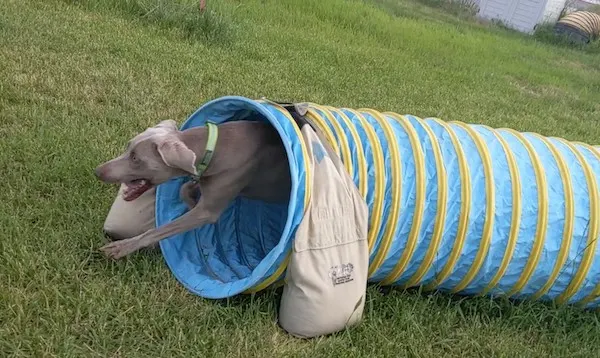
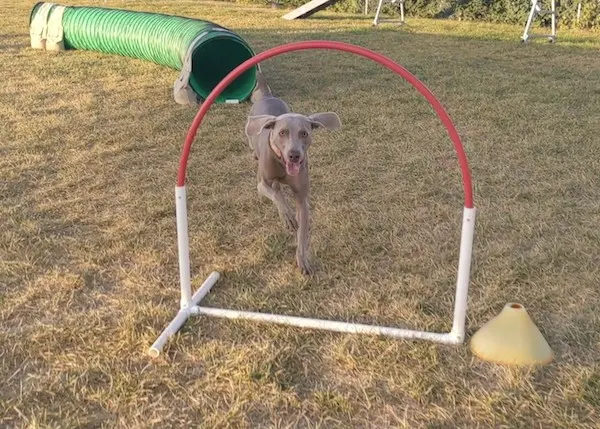
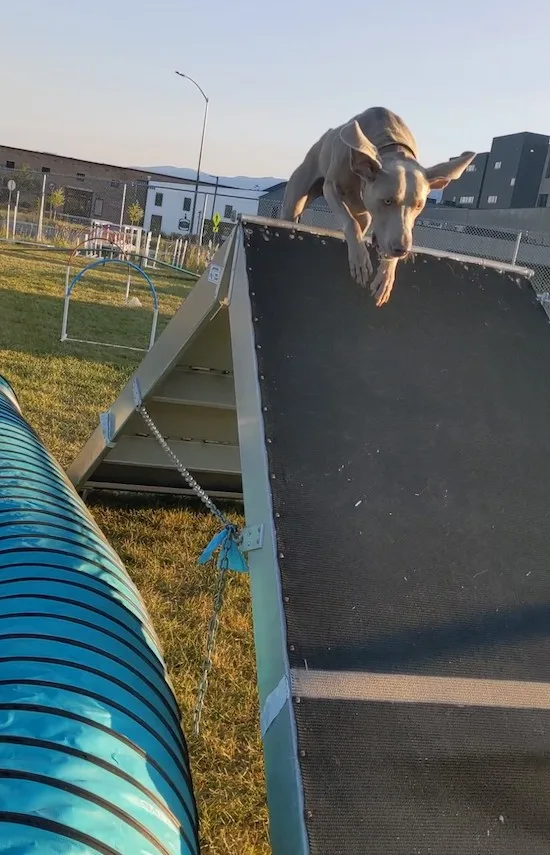
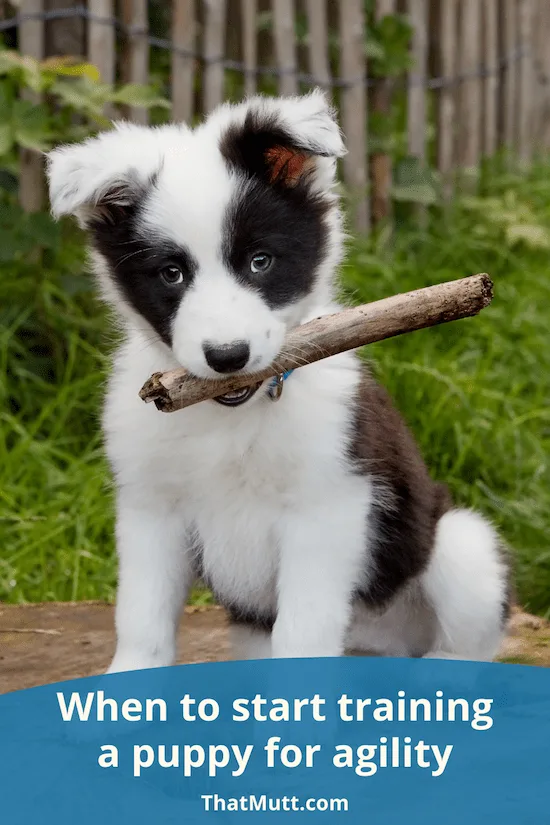
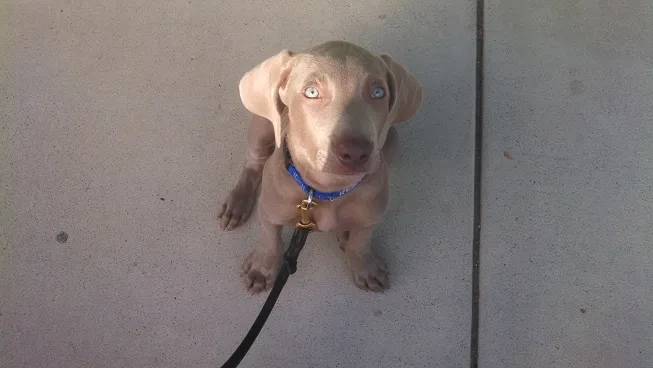
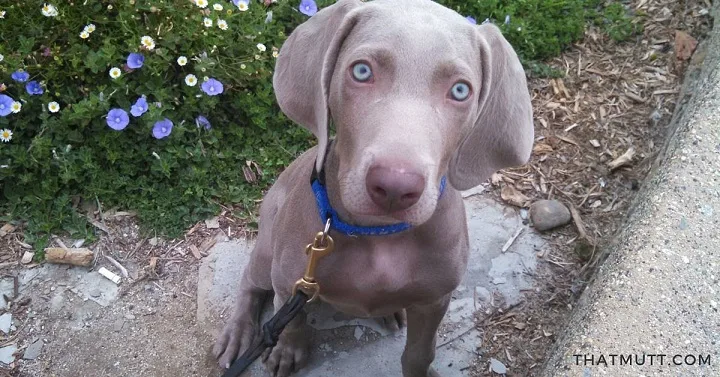
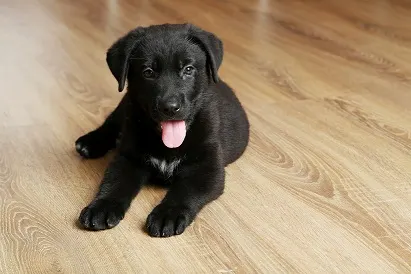
Rebecca
Saturday 13th of March 2021
Thank you! This article was very helpful. I’m interested in learning more about the ‘switch’ command. Maybe a video with it being used so I understand what to teach my puppy.
Lorrie
Tuesday 10th of August 2021
@Rebecca,
A switch is just a turn away command. We start by teaching our dogs to spin in a circle. Right hand turns the dog's head right, left hand turns them left. After they understand that, we will walk forward and teach them to spin and return to our side as we are walking. The third step is to do a 180 degree turn. As you walk forward with your dog at your side, you turn them away from you and pivot 180 degrees, then reward them with the other hand as you are moving back in the direction you came from. Finally, you add equipment - start next to a tunnel with the dog on the inside closer to the tunnel. Walk forward toward the entrance and encourage the dog to spin away into the tunnel entrance. We then move to rear crosses (same motion!) and turns away at a distance. Hope that is helpful.
Lorrie Reynolds Maximum Fun Dog Sports
Lindsay Stordahl
Saturday 13th of March 2021
So glad you were able to check out our article. Switch is hard for me to explain! Haha. I'll have to do a video or write more on it sometime. There are some existing youtube videos on it but nothing that shows it in simple, clear terms.
KL
Friday 12th of March 2021
I’ve seen some sport foundation classes for puppies that involve some of the skills you mention. If not for COVID, I’d have put my puppy in one of those classes and we’d be searching out puppy agility/foundation work by now (he’s 9 months old). As it is, I won’t attend an indoor class until I’m vaccinated, so we haven’t done much. I’m hoping once more of us are vaccinated, it will be safer to do more. I plan to put this puppy in Nosework, but he’s a very physically active dog in ways my older dog was not, so he may enjoy agility more. Sandy brought up really good points about mental maturity and about jump height. My puppy may be doing Preferred classes if we trial someday. I haven’t really made any decisions about that just because who knows if he will even like it, but it’s something I’ve considered.
Lindsay Stordahl
Saturday 13th of March 2021
It will be fun to see what he likes and what he's good at!
Sandy Sutter
Tuesday 9th of March 2021
Most dog training facilities where I live either don’t allow dogs under 12 months in their classes or they restrict them to floor work. I have found my GSDs mentally don’t mature until about 4 years old and often they don’t fill out and the chest doesn’t drop until between 3 and 4. Even though my GSDs, with the exception of Jack, have had perfect or near perfect hips I have jumped them at 20 inches. If there is a class with lots of jumping, I will put the bars down to 16 inches. I did this even with Tug who measured at 28 inches. I am happy you are advocating lower jump heights and waiting until the dog is more mature to start heavy training. I have seen too many broken down dogs.
Lindsay Stordahl
Wednesday 10th of March 2021
Thank you for helping me with agility back in Fargo with Ace! I remember the first class I took with him there required dogs to be 18 months old, which was good because we did jumps and contact obstacles almost right away. My current dog Remy is finally mentally mature now at 5 years old. With jumps, I do the same as you. I barely even work on jumps at all (I use the hoops on the ground) but when we do have jumps they're at 12" or 16". Another interesting factor ... a lot of dog parks now have agility equipment set up and people without the training are having their dogs run and climb and play on these obstacles. This has its pluses and minuses. It's a common thing in my area.